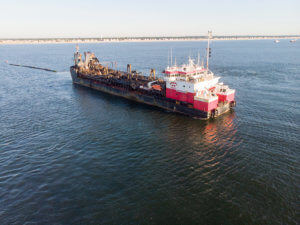 The Northeast Shore & Beach Preservation Association (NSBPA) and the Monmouth University Urban Coast Institute will co-sponsor a Beneficial Use of Dredge Material for Coastal Resilience Workshop on Sept. 24 at Monmouth University. This event is free to students and $40 for non-student attendees (includes lunch and coffee breaks).
The Northeast Shore & Beach Preservation Association (NSBPA) and the Monmouth University Urban Coast Institute will co-sponsor a Beneficial Use of Dredge Material for Coastal Resilience Workshop on Sept. 24 at Monmouth University. This event is free to students and $40 for non-student attendees (includes lunch and coffee breaks).
The event was originally scheduled for May 19, but postponed to Sept. 24 in accordance with public health professionals’ best estimates of the COVID-19 pandemic’s trajectory and timeline.
Mid-Atlantic and New England states are embarking on the development of coastal resilience plans that utilize natural and nature-based features (NNBF) to enhance both ecosystem resilience and provide green infrastructure to better protect communities from the impacts of flooding and sea level rise. Many NNBF projects require sediment for construction and often utilize local navigation channel dredging as an opportunity to beneficially reuse dredge material for their construction, lowering costs and allowing natural processes to resolve coastal problems and improve the environment. Regional approaches to the management of sediments (regional sediment management, or RSM) and the beneficial use of dredge material (BUDM) are therefore critical components for ecosystem resilience and community flood risk reduction.
A number of pilot projects have already been constructed in the region, providing valuable insights into the design and performance of NNBF. The NSBPA workshop on the Beneficial Use of Dredge Material for Coastal Resilience will provide a forum for coastal practitioners and regulators to discuss successes and challenges in the use of RSM and BUDM for coastal resilience.
The goals of the workshop are to:
1. Improve understanding of the magnitude of coastal wetland and sediment loss in the region due to sea level rise, erosion, and dredging
2. Provide case studies for resilient and sustainable restored and created wetlands using dredged sediments
3. Discuss barriers and opportunities for the implementation of projects
